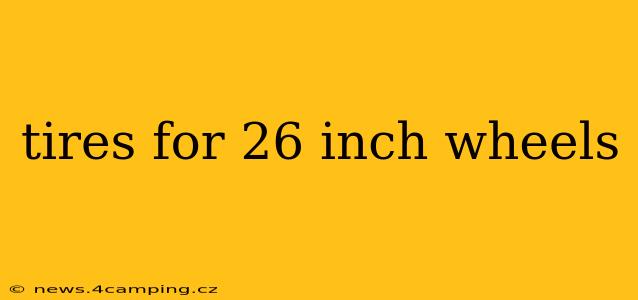Choosing the right tires for your 26-inch wheels can significantly impact your riding experience, whether you're a mountain biker tackling rugged trails, a commuter navigating city streets, or a casual cyclist enjoying paved paths. This guide will help you navigate the world of 26-inch tires, ensuring you find the perfect fit for your needs and riding style.
What are the different types of 26-inch tires?
26-inch tires are categorized primarily by their intended use and tread pattern. The most common types include:
-
Mountain Bike Tires: These tires feature aggressive tread patterns with deep knobs for superior traction on dirt, gravel, and rocks. They are often wider than other types of 26-inch tires to provide stability and grip on uneven terrain. Sub-categories within mountain bike tires include:
- Cross-country (XC): Lighter and faster-rolling tires with a less aggressive tread for smoother trails.
- All-mountain (AM): Versatile tires suitable for a wider range of trails, offering a balance of traction and rolling efficiency.
- Downhill (DH): Heavy-duty tires with extremely aggressive tread patterns designed for maximum grip and stability on steep, technical descents.
-
Hybrid/City Tires: Designed for paved surfaces, these tires offer a smoother ride and are often narrower than mountain bike tires. They generally have a less aggressive tread pattern, prioritizing rolling efficiency and comfort over off-road traction.
-
Road/Touring Tires: These are typically the narrowest 26-inch tires, offering minimal rolling resistance for speed on paved roads. They usually have a smooth tread pattern. However, finding 26-inch road tires might be challenging as this wheel size is less common for road bikes nowadays.
What is the right tire width for my 26-inch wheels?
Tire width is measured in millimeters (mm) and is crucial for determining performance and suitability for different terrains. Generally:
- Narrower tires (under 1.75 inches or ~44mm): Offer faster rolling speeds and are suitable for paved surfaces. They provide less cushioning and grip on rough terrain.
- Wider tires (1.75 inches or ~44mm to 2.5 inches or ~63mm): Provide better grip and cushioning on rougher surfaces, but may roll slower on paved roads.
What PSI should I inflate my 26-inch tires to?
The recommended PSI (pounds per square inch) is usually printed on the sidewall of the tire. However, this is just a starting point. The ideal PSI depends on several factors, including:
- Rider weight: Heavier riders may need higher PSI.
- Terrain: Rougher terrain often requires lower PSI for better grip and cushioning.
- Tire type: Wider tires generally require lower PSI than narrower tires.
Experimenting with different PSI levels to find what feels most comfortable and provides optimal performance is recommended. Always ensure the PSI is within the range specified on the tire sidewall.
What are the common tire compounds used in 26-inch tires?
Tire compounds affect grip, rolling resistance, and durability. Common compounds include:
- Rubber compounds: The most common and vary in hardness (durometer). Softer compounds offer better grip but wear out faster, while harder compounds last longer but may have less grip.
How do I know what size tire fits my 26-inch wheels?
The size of your tire is typically indicated on the sidewall, for example, 26 x 1.95. The first number (26) refers to the wheel diameter, while the second number (1.95) indicates the tire width. Always check the compatibility of the new tire with your wheel rim before purchasing.
Where can I buy 26-inch tires?
26-inch tires are available from a variety of retailers, both online and brick-and-mortar stores. Local bike shops are a great resource for personalized advice and recommendations.
By understanding these key factors, you can confidently select the perfect 26-inch tires to elevate your cycling experience. Remember to always prioritize safety and choose tires appropriate for your riding style and terrain.
